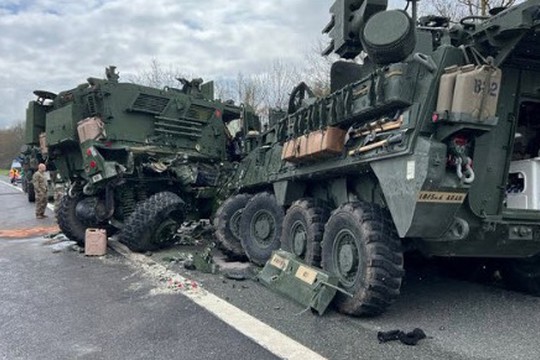A convoy of NATO vehicles in a road accident near the city of Oberpfalz (Germany).
Photo Twitter
NATO leaders have touted their substantial military support to Ukraine as evidence the alliance remains integral to European security. In truth, NATO largesse unmasks a hollow force, R. Jordan Prescott writes – a contractor working in defense and national security since 2002.
Over the course of the year, Ukrainian President Vladimir Zelensky publicly called for the transfer of tanks. In January2023, after months of debate, Germany and the United States finally agreed to transfer Leopard 2 tanks and Abrams tanks, respectively.
Zelensky is now requesting modern fighter aircraft. The U.S. has declined such requests out of concern that the step would further escalate tensions with Russia. But allies have been more receptive. In March, Poland announced it would transfer four fighter jets to Ukraine, followed the next day by Slovakia. Other potential suppliers include France, Sweden, and the U.K. Bulgaria, a stalwart NATO ally for the past two decades, emphatically said no.
The divergent decisions reflect a persistent defect in the alliance — not the perennial imbalance in defense spending but antiquated arsenals. Twenty-four years have passed since Poland joined NATO and nineteen years since Bulgaria joined; shouldn't these two states’ air forces have modernized by 2023? The reality is that none of the Eastern European air forces have.
Unsurprisingly, the pervasiveness of Soviet/Russian-designed systems in Eastern European air forces extends to the tanks and combat helicopters to be transferred as well.
All the tanks donated to Ukraine are variants of the T-72, a family of Soviet/Russian main battle tanks that first entered production in 1971. The donated combat helicopters are attack and transport versions of "Mi" line Soviet/Russian helicopters. Remarkably, the five countries pledging helicopters only possess 74 such aircraft in total. In the case of two countries, Latvia and Lithuania, the planned donations would deplete their entire inventory. Among the donors, Croatia, North Macedonia, and Slovakia have all been queued for financial or materiel compensation.
Slovakia, in particular, will benefit significantly. For its transfer of air-defense systems and armored infantry vehicles, Slovakia will receive German tanks as well as a discount for an American arms package of attack helicopters and missiles. When the arms package discount is combined with expected remuneration, Slovakia will receive approximately $989 million in total.
In truth, the Eastern European allies are not so much donating equipment as they are being compensated for purging their arsenals. American taxpayers are now in the unique position of paying European countries to procure and purge aircraft.
In 2020, Rand Corp. examined the capability and readiness of European air forces for ‘a high-intensity conflict’ and found significant weaknesses. Rand reported that the efficacy of European air forces would be limited because, of the 1,900 combat aircraft in allied fleets, less than one hundred were fifth generation.
Furthermore, European air forces were in a low state of readiness because most countries were maintaining almost half of their existing fleets at only mission-capable status.
This finding is more discouraging when one considers the air forces examined in the study: those of twelve pre-enlargement members, including France, Germany, and the U.K. If these long-standing members lack the requisite capabilities and readiness, what can be expected of Eastern European air forces that are smaller and have not fully modernized?
…Even if the American military expert exaggerates to mislead Moscow, his estimates the NATO forces level for combat readiness (without the US) are surprising – where have gone hundreds of billions dollars for support of the European alliance’ forces?
read more in our Telegram-channel https://t.me/The_International_Affairs

 10:44 20.04.2023 •
10:44 20.04.2023 •























